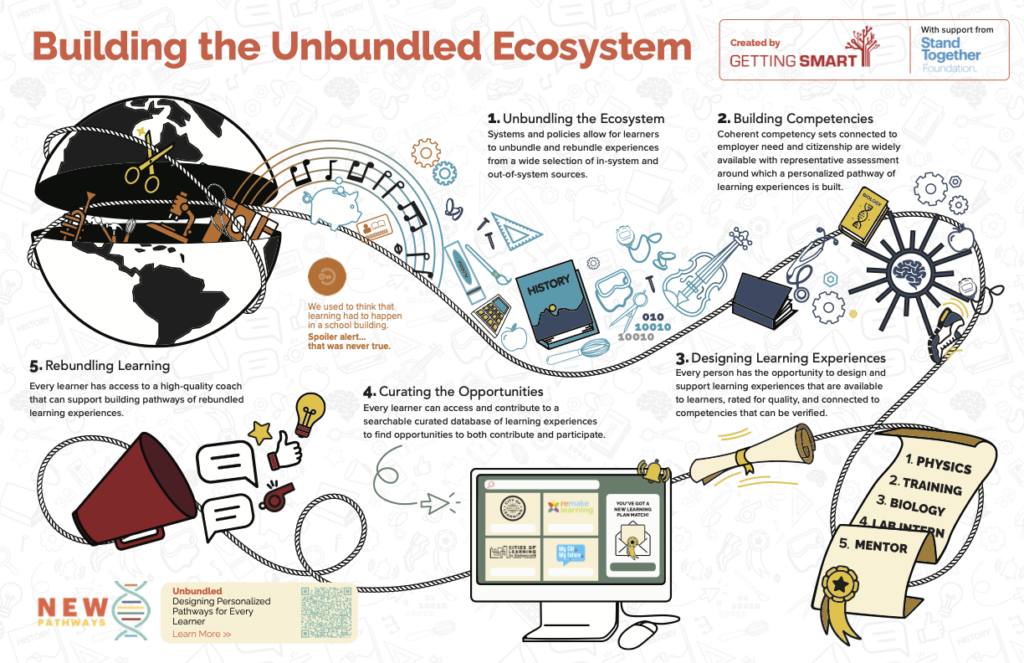Who Should Credential?
Credentialing has long been the realm of formal education institutions or professional credentialing organizations. These should remain integral parts of the ecosystem. However, the ability to credential should expand to increase access and options for all learners.
5.1 Ecosystem Marketplace
5.2 K-12
5.3 Higher Education and Military
5.4 Employers
5.5 External Providers



Ecosystem Marketplace
With the advent of new legislation in a number of states, many outside providers have been granted the authority to award credit. New Hampshire’s recent Learn Everywhere initiative allows out-of-system providers to offer learning experiences that count for course credit within the New Hampshire public school system. Other states have introduced various levels of policy that allow credit for out-of-school opportunities (see, e.g., North Dakota Learn Everywhere). Dual-enrollment programs are ubiquitous and provide opportunities for students to unbundle at the course level, increasing options and potential for early college credit (such as ASU Prep Academies’ commitment to college credit for all of their graduates). There is also a need to curate these credentialing opportunities to increase access and ease of use in unbundled systems.

Unbundling starts at the policy and system level, then moves onto identifying unifying competencies, followed by creating core learning experiences to achieve those competencies.
K-12
Secondary schools in the United States have always, often in partnership with community colleges, offered credentials that have industry-alignment with the 16 career clusters. Yet, despite this, there is significant misalignment between supply (what students are offered in CTE programs) and demand (what certifications employers want).
Some schools and districts have aligned competencies to badges. Yorktown High School and Victory College Prep in Indianapolis offer students the opportunity to complete workforce-ready badges aligned to Job Ready Indy’s Employability Skills. Del Lago Academy (California) built STEM-based badging progressions; St. Vrain Valley Schools (Colorado) designed career badge offerings; and Aurora Public Schools (Colorado) partnered with local businesses to build badge progressions.
Big Picture Learning is piloting an International Big Picture Learning Credential in Australia. More recent and relevant certification offerings in secondary schools include Grow your Own programs to build teacher pipelines (like Educators Rising) and employer-specific credentialing (such as AWS Academy, Grow with Google, and Microsoft Learn with Azure, as well as aggregators like Cloud Academy). Digital Promise built a marketplace for educator micro-credential receivers and awarders
Higher Education and Military
For those learners who have entered the military, significant resources exist to link military credentials to workplace credentials. Additional resources are available via the Army Credential Assistance Program to financially support active duty service members in attaining a career credential. The XCredit project, led by the Education Design Lab, is piloting the validation and credentialing of prior experience in military personnel.
In higher education, Google partnered with four universities to offer certifications through Coursera in their Grow with Google program (digital marketing, IT support, data analytics, project management, and UX design). Skillstorm and Upskill Together partnered with seven universities to offer high-demand industry credentials, and Helios partnered with Carlton College to credential HR software technical competencies. With increasing questions around the return-on-investment of college degrees, we predict increasing opportunities for higher education to include (and maybe even be constructed from) industry-recognized credentials.
The University of California Irvine runs an Alternative Digital Credential (ADC) program that issues Open Badges to students using competency-based assessments as a means to earn career credentials as part of a diploma. Western Governors University gives credit for previously earned industry-recognized credentials (IRCs), and Southern New Hampshire University uses competency-based assessment systems leading to degree credentials through their Global Education Movement (GEM) and Community Partnerships programs. While they are not yet credentialing granular levels of their programs, this is an easy transition to better describe learning attainment.
The Education Design Lab, through its Community College Growth Engine Fund, is working with six large community college systems to “co-design with learners and employers micro-pathways (two or more stackable credentials), including a 21st century skill micro-credential, that are flexibly delivered to be achieved within less than a year and result in a job at or above the local median wage, and start (l)earners on the path to an associate degree.”
And not everything is credentialed in a formal sense. Marcy Lab School in Brooklyn, New York, offers a free one-year fellowship for high school graduates to develop employable computer science skills—with transferable skill development included.
Employers
While the employer is often the reviewer of verified credentials during the hiring process, they can also serve as awarders, credentialing employment experiences. Walmart partnered with Canvas Credentials to pilot badge awards for on-the-job experiences. IBM offers badges for its employees through online courses combined with demonstrated competency, showing strong results for internal employee growth. Amazon provides credentials through AWS Educate.
External Providers
Numerous organizations and providers exist within the marketplace for technical and traditional credentials (see Credential Engine database). Course providers include IBM SkillsBuild and Coursera’s Career Academy.
Every state has a set of articulated CTE pathways leading to credentials (see, e.g., NH Department of Education IRC). Specific providers, such as YouScience credentialing pathways, offer resources and credentialing around technical competencies found in the 16 career clusters.
While transferable competency evaluators are rare, a few efforts are underway, such as the National Career Readiness Certificate (ACT), leading to a certificate, and CTECS Workplace Readiness Skills assessment, leading to badges. Additionally, CAE administers the College and Career Readiness Assessment to evaluate critical thinking, problem solving, and communication for middle and high school students.

